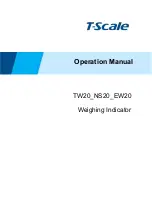
6
2.0 Preparations Before Operation and Testing Techniques
2.1 Preparing for Operation
Toll-free Hotline for Technical Service
: If you have any questions or problems, call our Toll-free Hotline at
1.800.922.5242 Monday - Friday between 8:00 AM - 5:00 PM Eastern Standard Time, or send an E-mail to
[email protected]. It will be a pleasure to help you.
Remove Red Dust Cover Plug
from sample tube hole before testing. (Retain it to prevent dust penetration
during inactive storage).
Install the Supplied 3 AA Batteries:
Remove cover on bottom of instrument and insert batteries (observe
correct polarity for each). If the 942 is not expected to be used for periods exceeding 3 months, remove the
batteries to avoid damage due to possible battery leakage.
Low-Battery Warning
: The 942 self-checks the battery condition as each test is started. When the battery
condition has weakened to a pre-set level, the display reads “Battery Low.” Replace all 3 batteries promptly
to avoid inaccurate readings. Calibration memory will not be lost during battery replacement.
When Replacing Batteries
, use only fresh 1.5v AA alkaline batteries. Install with polarities as shown in bat-
tery holder. Always replace all 3 batteries at the same time, and do not use a mixture of different brands.
Automatic Power-off:
To conserve battery life, the Model 942 shuts itself off automatically 15 minutes after
the last key pressed.
2.2 General Operating Details and Techniques
Taking Water Samples:
For the highest accuracy, be very careful to ensure that water samples are truly representative. Water sam-
ples taken from pipes or wells should be allowed to run sufficiently to flush out sediments or standing water.
To get a truly representative test value from surface waters, it may be necessary to take samples at various
locations and depths, and even at different times of day or night.
Sample containers should be scrupulously clean. An accepted general method of cleaning containers prior
to use consists of taking the following steps. First, clean with a lab detergent. Then flush thoroughly with
tap water. Next, rinse with R-405 1:1 Hydrochloric Acid or R-1119 1:1 Nitric Acid, and rinse thoroughly with
distilled or R-3684 Deionized Water. Repeat several times.
Special instructions are given in the Specific Test Procedure (section 7) if unusual preliminary steps must be
taken.
It is best to test samples as quickly as possible after they have been collected, especially when you have
reason to believe the concentration will be low. If this is not possible, see below.
Содержание 942-095
Страница 1: ...Series 942 The Mini Analyst Instruction Manual 942 095 Hardness Total Low Range...
Страница 23: ...23...







































